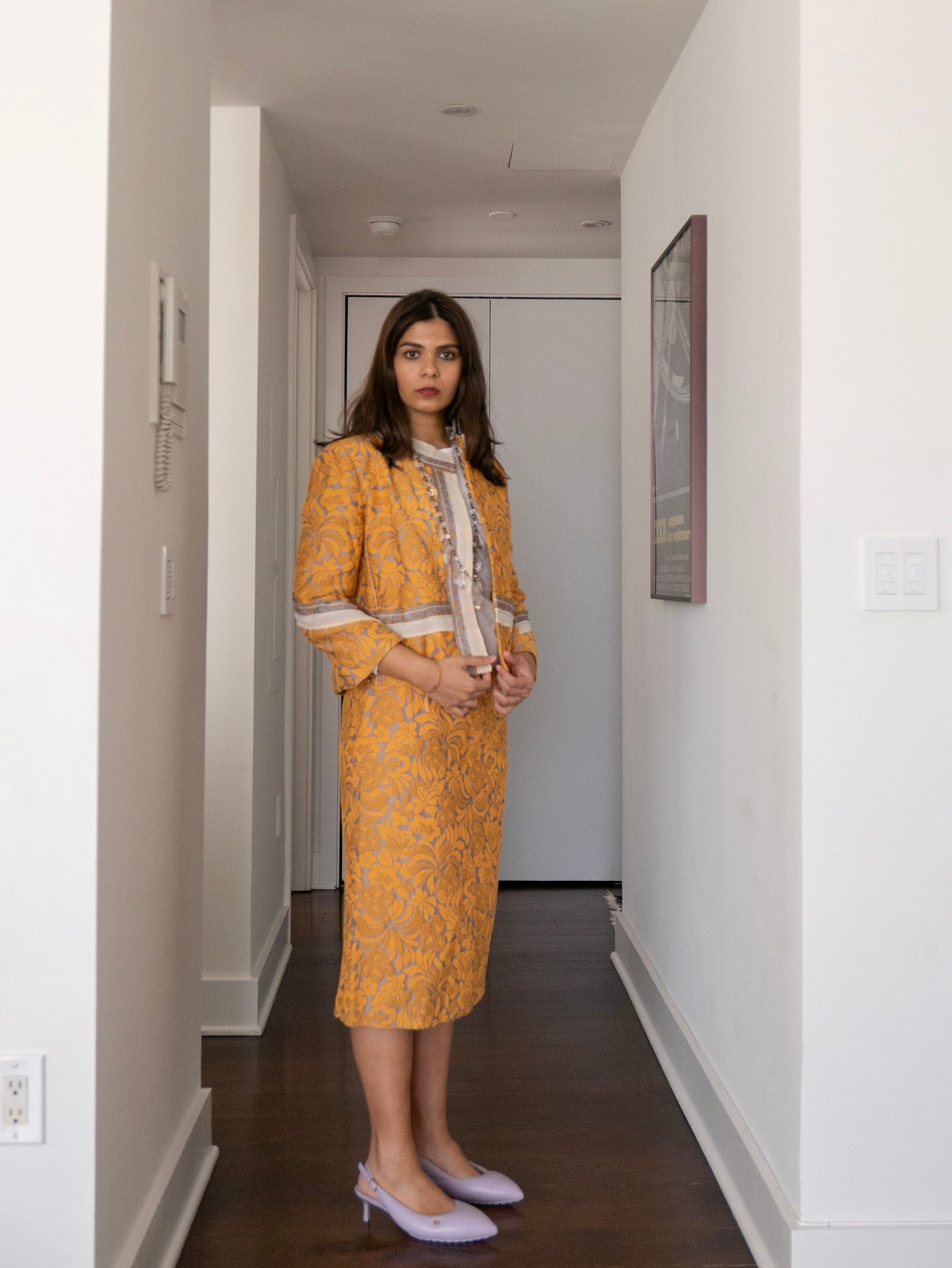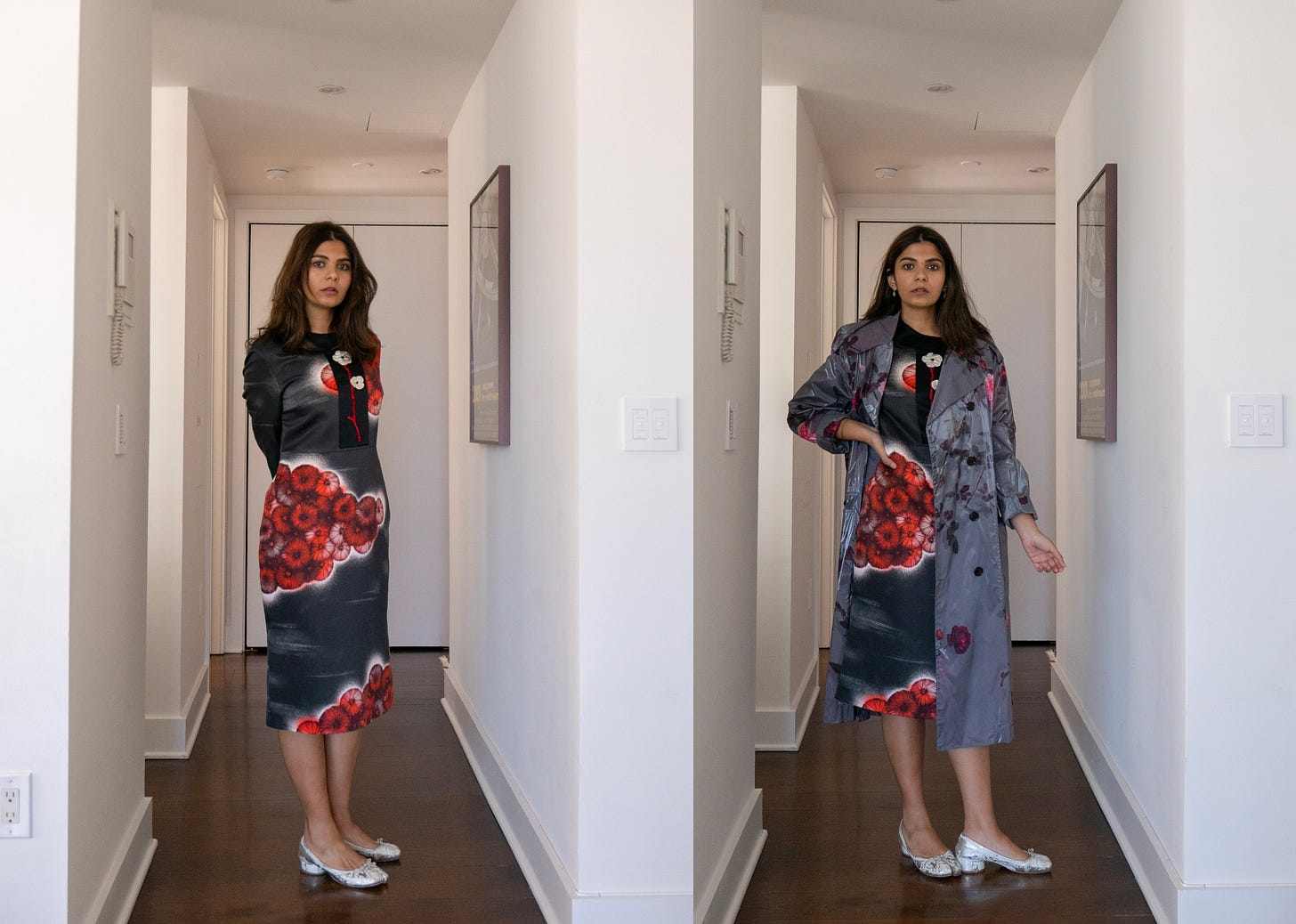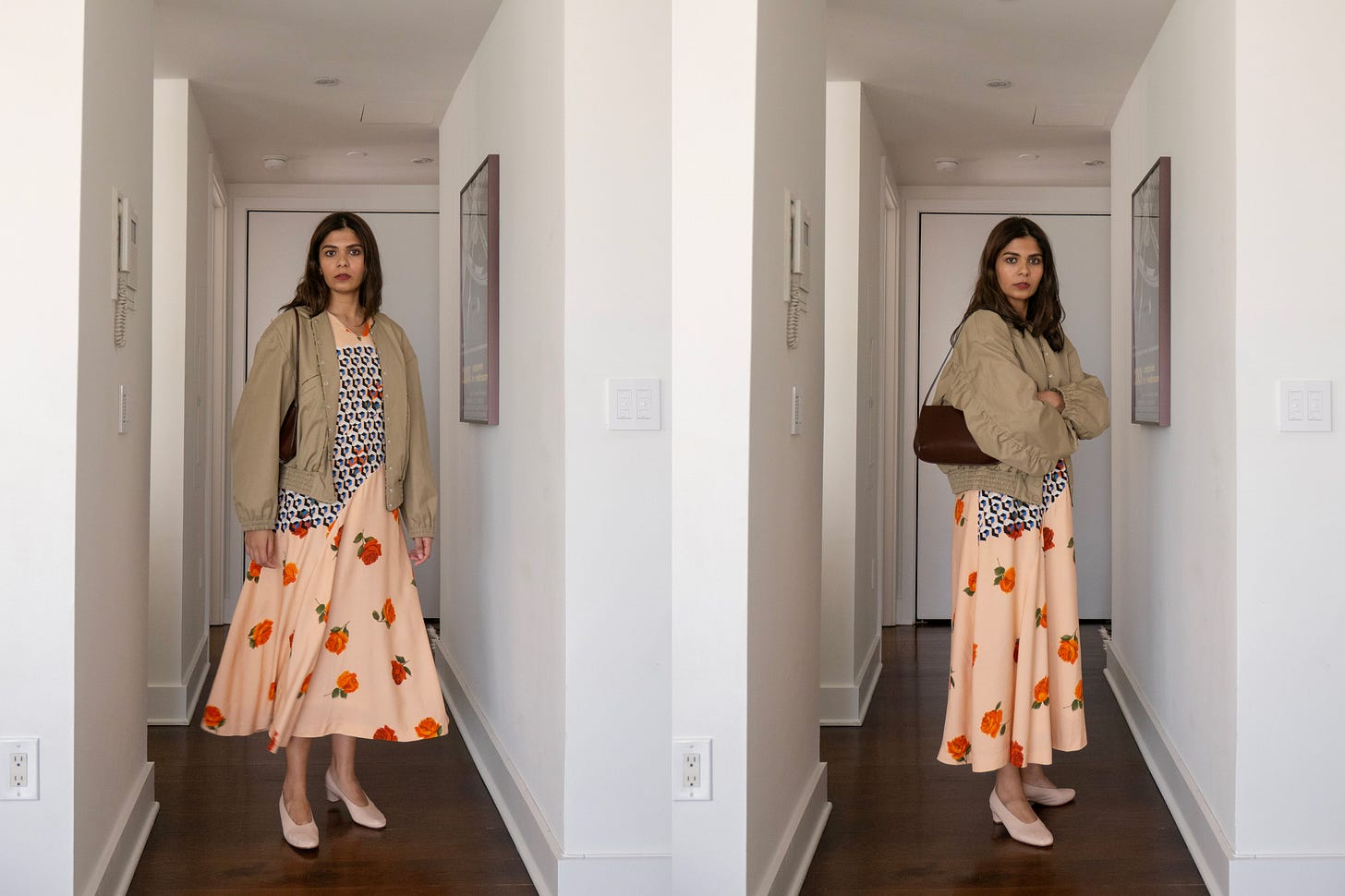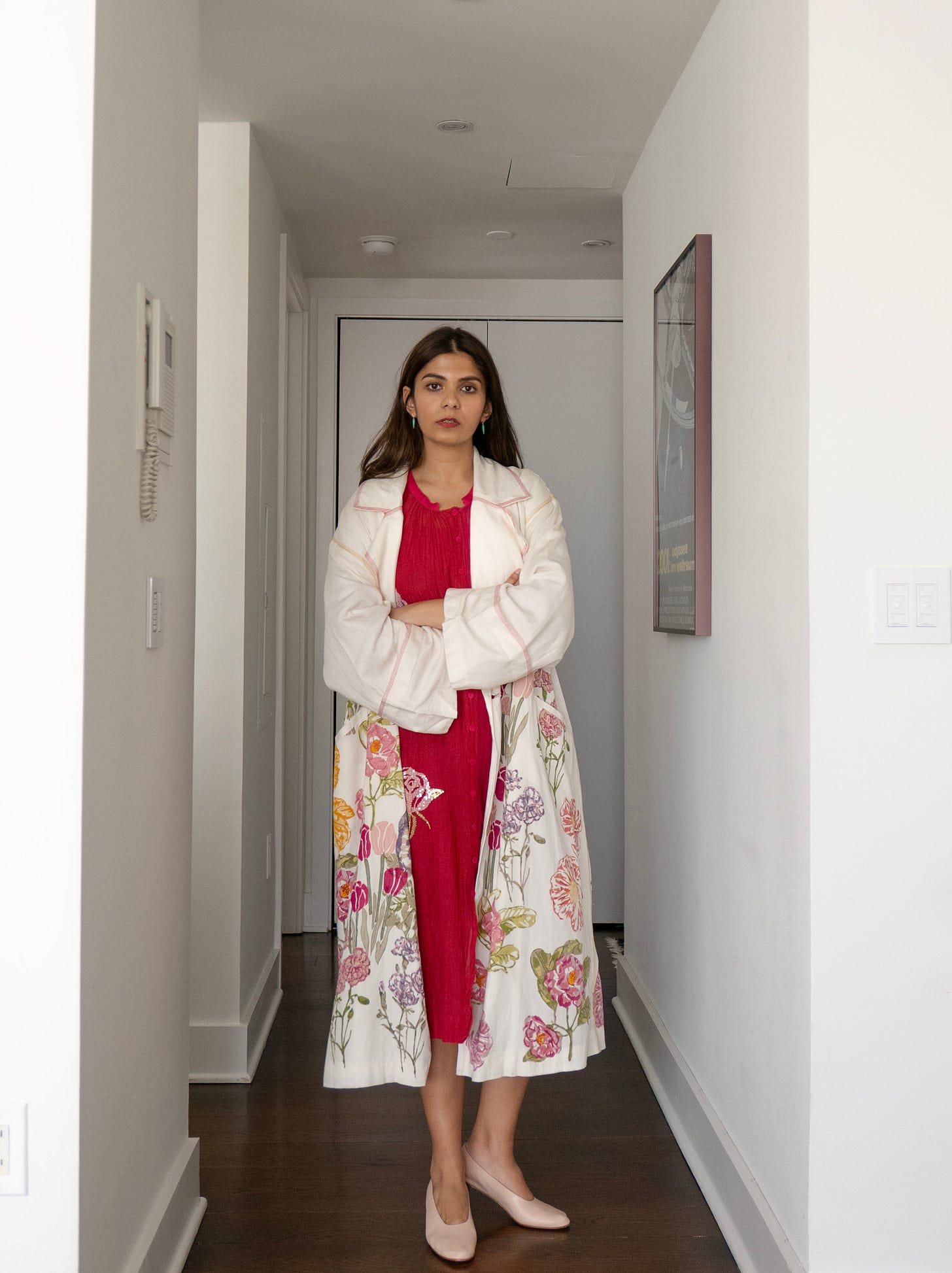049: Florals for Spring
Outfits for the swiftest season
One evening last week, I was walking down the Hudson River Park, which is sandwiched between the breezy Hudson River and the rush of the West Side Highway. It was one of the first fleeting and blissful spring days. Along the way, I passed flower patches planted in the grass – tulips being the main feature – and they were swaying in the breeze and even though the sun had almost entirely descended, their bright colors had cast a kind of luminous glow around them. Something about this scene was very touching to me, and the way that the flowers moved made them appear rather cheeky, their lips pursed and their heads turned up and away.
Yesterday I stopped at Jane Street Garden for a brief rest. Of all the city’s secret gardens, this one is perhaps my favorite. When I had passed the garden some time ago on my way to my parents’, armed with a pistachio praline and vanilla sponge cake to celebrate my father’s seventy-first birthday, which is incidentally the day before the Bengali New Year and twelve days after mine, its keepers were planting up a storm. I find it very soothing to watch people gardening, their gloves and hands browned with soil; potting a new plant or sowing seeds is one of my mother’s greatest pleasures. These tulips had now opened into wide smiles, exposing their stamens and stigmas and the secret colors they held within them for the season thus far. It is this exact moment of the tulips’ ephemeral nature I love most. When I first moved to New York, I had bought bright red tulips in brown plastic planters for my fire escape. I used to wake up feeling like I was in heaven, and when a terrible storm knocked them all over, soil spilling from their containers, I let what remained of them roll around on the platform until eventually every petal had dispersed.
Spring is my favorite season; it produces an effect of relief after the grey and cold winters. Some years ago I began buying flowers for myself during the springtime. My therapist’s office was near Union Square, and my visits coincided with when the farmer’s market opened. It seemed to me a fair exchange for exorcising my demons. Most recently, I treated myself to branches of lilacs, which I’d never bought before and made the living room smell heavenly, and robust red tulips, that over the course of time revealed beautiful shades of yellow and black within.
Dressing for this time of has become something of a sport for me: so many flimsy spring jackets to wear, such little time! A lot of what I own, I’ve come to realize, is shaped by the seasons, not just from a practicality standpoint, but they reflect the colors and textures of their time, from velvet dresses for winter, to a shocking number of floral pieces for, you guessed it, spring. My style has evolved into being quite on the nose and delights in a theme (give me a northeast beach and I’ll show you a sailor, that sort of thing). It seems a disservice to the sheer awesomeness of flowers to not embrace florals for spring, which has now rendered my wardrobe into a billboard for the season.
The majority of the clothes I own are secondhand. When Rana Plaza collapsed twelve years ago and exposed cracks that had long existed in the fashion industry, I felt ashamed to shop from fast-fashion retailers. Though my shopping habits were never egregious, I needed to curb my own contribution to a problem that had catastrophic consequences. I detached myself from the idea that I needed “basics” – the perfect white t-shirt, the perfect jeans – because that would keep me tethered to fast-fashion, and started frequenting thrift shops and sites like eBay and Etsy. I only bought clothes that really moved me: beautiful craftsmanship, pieces by designers I admired from collections I was bewitched by. Shopping in this way led me items such as sculptural Prada shoes from the 1990s to a vintage wool coat with a Ladies’ Garment Workers’ Union tag sewn on the inside.
With the exception of a Dries Van Noten bomber jacket and a set by Vineet Rahul, a sustainable Indian clothing brand, all the pieces below are secondhand. Although taking batches of outfit photos might seem a bit Narcissus adjacent (believe me, nothing gives me quite the scare quite like seeing myself on a screen), it can be useful to take stock of what you already own, the different ways they can be worn, what can benefit from a trip to the tailor, and the things that have no business being in your closet.
Of the dresses I own, this Dries Van Noten piece is the most resilient, having weathered gelato droppings, smearing of sauces, and sweaty summers. I have long disliked slip dresses as most are bias-cut, which does no favors for most bodies. This dress glides along my form, never cinching nor clinging, and worn on a windy day, the draped fluttering scarf is ever so romantic.
The Yohji Yamamoto jacket is made from a lightweight wool so premium, that its level of comfort and movement made me initially think it was viscose. Cleverly concealed just below the collar is a zipper that runs all the way down along the back which can be worn open. There is nothing I enjoy quite as much as clothes that contain little secrets.
Brocade holds a special place in my heart. As a child I was drawn to the colors and texture of brocade, being able to see the craft that went into its creation when turned inside out, and often wanted my traditional clothes for special occasions to be made from the material, although my mother would groan that it was so old-fashioned. Incredible craftsmanship never goes out of style, mum! It is my opinion that not enough of us are wearing brocade in our daily lives. Miuccia Prada is one of the few designers who has long been attempting to restore this imbalance, challenging outdated ideas of how we should dress.
This set and the dress and jacket below are few sizes up from what I usually wear; when shopping secondhand and particularly for pieces I’ve been on the lookout for for a while, I’m not too if fussed something fits a bit oversized as, if anything, I can have them tailored. But I also don’t mind if the fit is not so precise, as it produces an effect similar to that of a small child wearing their mother’s dresses and too-big shoes. And while I would not recommend wearing shoes that are too large, Martine Rose’s collaboration with Clarks from last year creates a similar illusion.
There is something rather delightfully perverse in Prada’s use of duchesse satin, a fabric traditionally reserved for couture, and more so when not worn in the context of formalwear. The soberness of the staid satin is offset by the cartoonish floral appliqué and print; don’t take yourself too seriously, I’m reminded when I put it own. “There are two opposites,” said the designer to journalist Suzy Menkes, “rectangular shapes, with folds, very geometric; with the flower as a symbol, of poetry, sentiment, community – those things that are always struggles in the life of women.”
The floral print on the jacket from Fall 2019 is quite literally straight from Dries Van Noten’s garden. Dries and his team picked and photographed flowers from his home the fall prior. By then the flowers had wilted, developed spots, and lost their luster, and the absence of their romance is precisely what the designer wanted to capture. Flowers in full bloom are beautiful, but in a state of decay they are just as arresting, romance replaced by melancholy.
Although this dispatch is about florals for spring, it’s worth mentioning how wonderfully Dries does florals for fall. Fall 2017 was the designer’s 100th runway show. Several of the prints from the show mixed and melded with those he’d created across the span of his career, with the rose pattern on this dress originally made for the first womenswear show in 1994.
I wear this dress at least once a week from moment the leaves turn until the stifling summer descends. To wear the same clothes over and over again can make some feel self-conscious, particularly when it seems as though online everyone is always wearing something new thought our virtual worlds are not representative of how real people are living in the real world, but I think of that as the demarcation line for style: those who are perpetually in brand new things have not yet found their’s, while those who settle into their clothes and take pride in them have found their rhythm.
On our last night in Lisbon a few years ago, my mother and I stumbled upon a shop called Conceptica. While my father and my husband dutifully played their roles as Bored Husbands Senior and Junior and waited outside, the two of us went in and were most pleasantly surprised by both the shop’s design and its contents. We met a gorgeous woman named Amy who worked there and she took us down the curving staircase to where all the clothes were. While my mother and Amy exchanged stories, I took in an armload of clothes by Vineet Rahul into the changing room. For very late September, the clothes I had packed were too warm. So few brands think to make summer clothing in lightweight fabrics, and among those that do are predominantly Indian and Japanese brands.
On it’s own, the dress is beautiful, embellished with green and pink sequins to form roses, but paired with the jacket…Because I don’t buy brand new clothing very often, I initially hesitated about buying both pieces, but then I thought, here’s a brand making handcrafted and sustainable clothing that fills gaps the fashion industry at large ignores, so if I can afford it, why shouldn’t I open my purse? And thank god I did!
As a questionably wise woman once said, “Florals for spring. Groundbreaking.”








I always really love your outfit pics! Said with the hope it will the dull the blade of the Narcissus feeling.
Your perspective and writing is such a joy , you're only one of two substack subscriptions I've maintained I even let Tina Brown lapsed :))